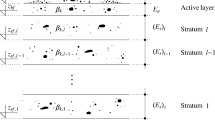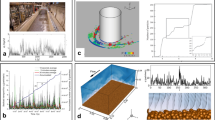Abstract
This work presents the development and calibration of a two dimensional river flow, sediment transport and bed evolution model that couples the active-layer and multiple size-class approach for sediment transport modeling with an enhanced advection algorithm. The governing equations are solved using the fractional step method. This resulted in three successive steps (advection, diffusion and continuity) for the flow equations, and two steps (advection and diffusion) for the sediment transport and bed evolution equations. The focus of the research is the improvement of the advection computation (both in water and sediment computation) by reducing the limitation it imposes on the time step. Overcoming this restriction is enabled by introducing modifications to the characteristic method. Implementing these adjustments allows the characteristic curve to extend throughout multiple computational cells. After evaluating the advection computation for both flow and sediment transport by comparison of the proposed algorithm with various classical methods, the developed model is assessed using field measurements conducted on the Danube River. Analysis of the measured and computed values confirmed the developed model’s reliability.
























Similar content being viewed by others
References
Appadu AR, Dauhoo MZ, Rughooputh SDDV (2008) Control of numerical effects of dispersion and dissipation in numerical schemes for efficient schock-capturing through an optimal Courant number. Comput Fluids 37:767–783
Benqué JP, Cunge JA, Feuillet J, Hauguel A, Holly FM Jr (1982) New method for tidal current computation. J Waterw Port Coast Ocean Div Proc ASCE 108(WW3):396–417
Biringen S, Chow C-Y (2011) An introduction to computational fluid mechanics by example. Wiley, Hoboken
Budinski L, Spasojević M (2013) 2-D modelling of flow and sediment interaction—sediment mixtures. J Waterw Port Coast Ocean Eng. doi:10.1061/(ASCE)WW.1943-5460.0000226
Crank J, Nicolson P (1996) A practical method for numerical evaluation of solutions of partial differential equations of the heat-conduction type. Adv Comput Math 6:207–226
Duan JG, Nanda SK (2006) Two-dimensional depth-averaged model simulation of suspended sediment concentration distribution in a groyne field. J Hydrol 327:426–437
Duan JG, Wang SY, Jia Y (2001) The application of the enhanced CCHE2D model to study the alluvial channel migration processes. J Hydraul Res 39(5):469–480
Ewing RE, Wang H (2001) A summary of numerical methods for time-dependent advection-dominated partial differential equations. J Comput Appl Math 128:423–445
Ferziger JH, Perić M (2002) Computational methods for fluid dynamics, 3rd edn. Springer, Berlin
Fletcher CAJ (1991) Computational techniques for fluid dynamics, vol 1, 2nd edn. Springer, Berlin
García MH (ed) (2008) Sedimentation engineering—processes, measurements, modeling and practice. American Society of Civil Engineers, Reston
Garcia M, Parker G (1991) Entrainment of bed sediment into suspension. J Hydraul Eng 117(4):414–435
Hirsch C (2007) Numerical computation of internal and external flows, vol 1, 2nd edn. Elsevier, Oxford
Hsieh TY, Yang JC (2003) Investigation on the suitability of two-dimensional depth-averaged models for bend-flow simulation. J Hydraul Eng 129(8):597–612
Hsieh TY, Yang JC (2004) Implicit two-step split-operator approach for modelling two-dimensional open channel flow. J Hydrosci Hydraul Eng 22(2):113–139
Holly FM Jr, Preissmann A (1977) Accurate calculation of transport in two dimensions. J Hydraul Div Proc Am Soc Civil Eng 103(HY11):1259–1277
Holly FM Jr, Usseglio-Polatera J-M (1984) Dispersion simulation in two-dimensional tidal flow. J Hydraul Eng 110(7):905–926
Hung MC, Hsieh TY, Wu CH, Yang JC (2009) Two-dimensional nonequlibrium noncohesive and cohesive sediment transport model. J Hydraul Eng 135(5):339–382
Isic M, Horvat Z, Spasojevic M (2013) Advection step in the split-operator approach applied to river modeling. Appl Numer Math 72:1–18
Jia Y, Wang SY (1999) Numerical model for channel flow and morphological change studies. J Hydraul Eng 125(9):737–749
Julien PY (2002) River mechanics. Cambridge University Press, Cambridge
Lax PD (1954) Weak solutions of nonlinear hyperbolic equations and their numerical computation. Commun Pure Appl Math 7:159–193
Lax P, Wendroff B (1960) Systems of conservation laws. Commun Pure Appl Math 13:217–237
Leonard BP (1979) A stable and accurate convective modelling procedure based on quadratic upstream interpolation. Comput Methods Appl Mech Eng 19:59–98
Lin B, Falconer RA (1996) Numerical modeling of three-dimensional suspended sediment for estuarine and coastal waters. J Hydraul Res 34(4):435–456
MacCormack RW (1969) The effect of viscosity in hypervelocity impact cratering. AIAA Paper 69-354
Minh Duc B, Wenka Th, Rodi W (1998) Depth-average numerical modeling of flow and sediment transport in the Elbe River. Proceedings of the 3rd international conference on hydroscience and engineering, Cottbus/Berlin, 31 Aug–3 Sept
Minh Duc B, Wenka T, Rodi W (2004) Numerical modeling of bed deformation in laboratory channels. J Hydraul Eng 130(9):894–904
Muste M, Yu K, Pratt T, Abraham D (2004a) Practical aspects of ADCP data use for quantification of mean river flow characteristics; Part II: fixed-vessel measurements. Flow Meas Instrum 15:17–28
Muste M, Yu K, Spasojevic M (2004b) Practical aspects of ADCP data use for quantification of mean river flow characteristics; Part I: moving-vessel measurements. Flow Meas Instrum 15:1–16
Nagata N, Hosoda T, Muramoto Y (2000) Numerical analysis of river channel processes with bank erosion. J Hydraul Eng 126(4):243–252
Papanicolaou A, Elhakeem M, Krallis G, Prakash S, Edinger J (2008) Sediment transport modeling review—current and future developments. J Hydraul Eng 138(4):1–14
Peaceman DW, Rachford HH Jr (1955) The numerical solution of parabolic and elliptic differential equations. J Soc Ind Appl Math 3(1):28–41
Rodi W (2000) Numerical calculations of flow and sediment transport in rivers. Proceedings of international symposium on stochastic hydraulics, Beijing, 25–28 July
Shimizu Y, Yamaguchi H, Itakura T (1990) Three-dimensional computation of flow and bed deformation. J Hydraul Eng 116(9):1090–1108
Spasojevic M, Holly FM Jr (1990) 2-D bed evolution in natural watercourses—new simulation approach. J Waterw Port Coast Ocean Eng 116(4):425–443
Spasojevic M, Holly FM Jr (2008) Two- and three-dimensional numerical simulation of mobile-bed hydrodynamics and sedimentation. In: García MH (ed) Sedimentation engineering—processes, measurements, modeling and practice. American Society of Civil Engineers, Reston, pp 683–761
Strikwerda JC (2004) Finite difference scemes and partial differential equations, 2nd edn. Society for Industrial and Applied Mathematics, Philadelphia
Thonon I, Jong K, Perk M, Middelkoop H (2007) Modelling floodplain sedimentation using particle tracking. Hydrol Process 21:1402–1412
Tsai T-L, Chiang S-W, Yang J-C (2006) Examination of characteristics method with cubic interpolation for advection–diffusion equation. Comput Fluids 35:1217–1227
van Rijn LC (1984a) Sediment transport, Part I: bed load transport. J Hydraul Eng 110(10):1431–1456
van Rijn LC (1984b) Sediment transport, Part II: suspended load transport. J Hydraul Eng 110(11):1613–1641
van Rijn LC (1987) Mathematical modeling of morphological processes in the case of suspended sediment transport. Delft Hydraulics Communication 382
Wang G, Xia J, Wu B (2008) Numerical simulation of longitudinal and lateral channel deformations in braided reach of the Lower Yellow River. J Hydraul Eng 134(8):1064–1078
Wu W, Rodi W, Wenka T (2000) 3D numerical modeling of flow and sediment transport in open chanels. J Hydraul Eng 126(1):4–15
Wu W (2004) Depth-averaged two-dimensional numerical modeling of unsteady flow and nonuniform sediment transport in open channels. J Hydraul Eng 130(10):1013–1024
Wu W (2008) Computational river dynamics. Taylor & Francis Group, London
Wu W, Wang SSY (2006) Formulas for sediment porosity and settling velocity. J Hydraul Eng 132(8):858–862
Yanenko NN (1971) The method of fractional steps. Translated by Holt M. Springer, New York
Zhou G, Wang H, Shao X, Jia D (2009) Numerical model for sediment transport and bed degradation in the Yangtze Channel Downstream of Three Gorges Reservoir. J Hydraul Eng 135(9):729–740
Acknowledgments
This work was funded by EU through Hungary–Serbia IPA Cross-border Co-operation Programme, Project Number HUSRB/0901/221/001; and the Ministry of Education and Science of the Republic of Serbia, Project Number TR 37009.
Author information
Authors and Affiliations
Corresponding author
Appendices
Appendix 1: Water flow model
Terms in the diffusion step equation, introduced to enable a more understandable representation of the extensive diffusion equation (2).
Dispersion terms in the diffusion step equation (2)
where upper index \(''\) denotes the difference between the actual and depth averaged velocity.
Appendix 2: Sediment transport and bed evolution model
The discretized divergence of the bed-load flux vector in Eqs. (26) and (27).
The dimensionless particle parameter
and the transport stage parameter
In Eqs. (29) and (37), \(\nu \) denotes the kinematic viscosity coefficient, \(V_*\) the bed-shear velocity, while \(V_*^{\mathrm{cr}}\) stands for the critical bed-shear velocity according to Shields.
Rights and permissions
About this article
Cite this article
Horvat, Z., Isic, M. & Spasojevic, M. Two dimensional river flow and sediment transport model. Environ Fluid Mech 15, 595–625 (2015). https://doi.org/10.1007/s10652-014-9375-y
Received:
Accepted:
Published:
Issue Date:
DOI: https://doi.org/10.1007/s10652-014-9375-y




